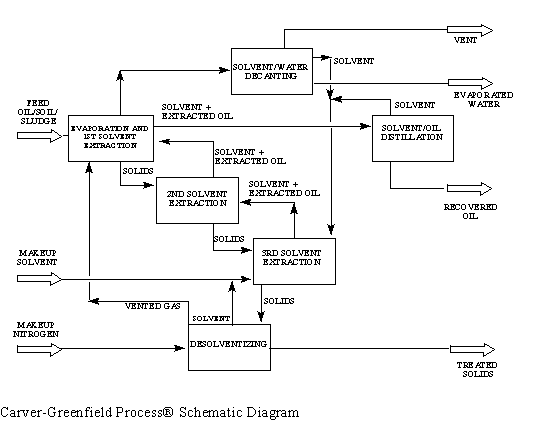
The Carver-Greenfield Process® (C-G Process) combines dehydration and solvent extraction technologies to separate wet, oily wastes into their constituent solid, water, and oil phases (see figure below).

Waste is first mixed with a low-cost hydrocarbon solvent. The resultant slurry mixture is fed to an evaporator system that vaporizes water and initiates solvent extraction of the indigenous oil. Depending on the water content of the feed, single-effect or energy-saving multi-effect evaporators may be used. Next, the slurry of dried solids is treated in a multistage solvent extraction unit, where solids contact recycled solvent until the target amount of indigenous oil is removed.
Finally, solids are centrifuged away from the solvent, followed by "desolventizing," an operation that evaporates residual solvent. The final solids product typically contains less than 2 percent water and less than 1 percent solvent. The spent solvent, which contains the extracted indigenous oil, is distilled to separate the solvent for reuse, and the oil for recovery or disposal.
The C-G Process yields (1) a clean, dry solid; (2) a water product virtually free of solids, indigenous oil, and solvent; and (3) the extracted indigenous oil, which contains the hazardous hydrocarbon-soluble feed components.
The C-G Process combination of dehydration and solvent extraction has the following advantages: (1) any emulsions initially present are broken and potential emulsion formation is prevented; (2) solvent extraction is more efficient because water is not present; and (3) the dry solids product is stabilized more readily if required (for example, if metals contamination is a concern).
The C-G Process can treat sludges, soils, sediments, and other water-bearing wastes containing hydrocarbon-soluble hazardous compounds, including polychlorinated biphenyls, polynuclear aromatic hydrocarbons, and dioxins. The process has been commercially applied to municipal wastewater sludge, paper mill sludge, rendering waste, pharmaceutical plant sludge, and other wastes.
The C-G Process was accepted into the SITE program in 1990. The pilot-scale SITE demonstration of this technology was completed in August 1991 at EPA's research facility in Edison, New Jersey. Spent petroleum drilling fluids from the PAB oil site in Abbeville, Louisiana were used as process feed. The Applications Analysis Report (EPA/540/AR-92/002), Technology Demonstration Summary (EPA/540/SR-92/002), and Technology Evaluation Report (EPA/540/R-92/002) are available from EPA.
The SITE demonstration of the C-G Process yielded the following results:
EPA PROJECT MANAGER:
Laurel Staley
U.S. EPA
National Risk Management Research Laboratory
26 West Martin Luther King Drive
Cincinnati, OH 45268
513-569-7863
Fax: 513-569-7105
TECHNOLOGY DEVELOPER CONTACT:
Theodore Trowbridge
Dehydro-Tech Corporation
401 Towne Center Drive
Hillsborough Township
Somerville, NJ 08876
908-904-1606
Fax: 908-904-1561